This EASY Australian Pavlova recipe is all about that crunchy, chewy meringue shell and soft, pillowy marshmallow centre. Have the meringue base in the oven in just 15 minutes! Includes recipe video, step-by-step instructions and creative topping ideas.
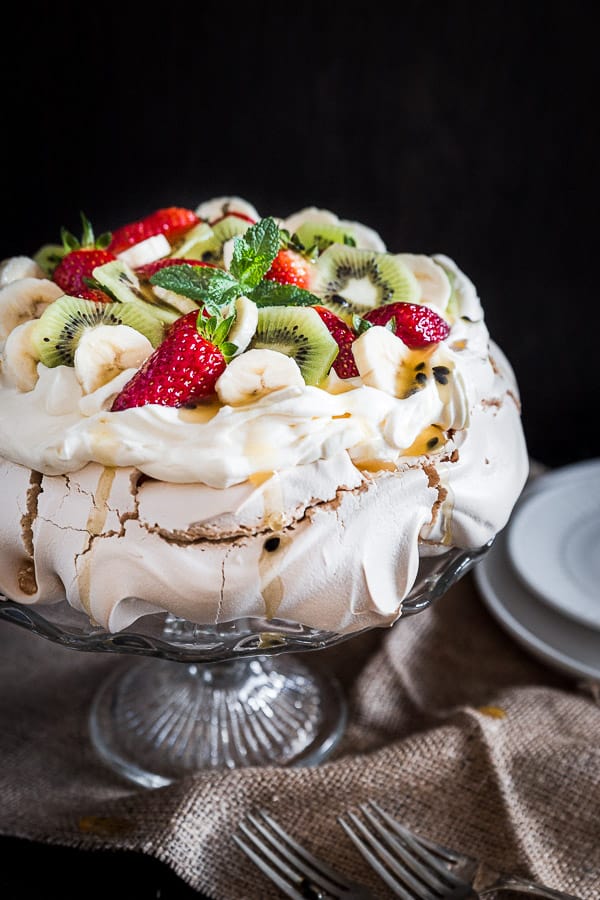
Why We Love This
Pavlova reminds us of backyard BBQ’s spent with friends under the summer sun. Just like custard trifle and ice cream pudding, it’s a beloved dish at Christmas time in Australia. Especially good after a heavy roast lunch, it’s the perfect light and fluffy dessert that leaves you feeling light and not sick from an overabundance of sugar.
To this day we’re not sure whether the crunchy outer shell or melty marshmallow centre is our favourite part of this dessert. Maybe it’s both!
What about you? What’s your favourite way to eat pavlova? Looking for more pavlova ideas? Try our pavlova roll (meringue roulade) or eton mess!
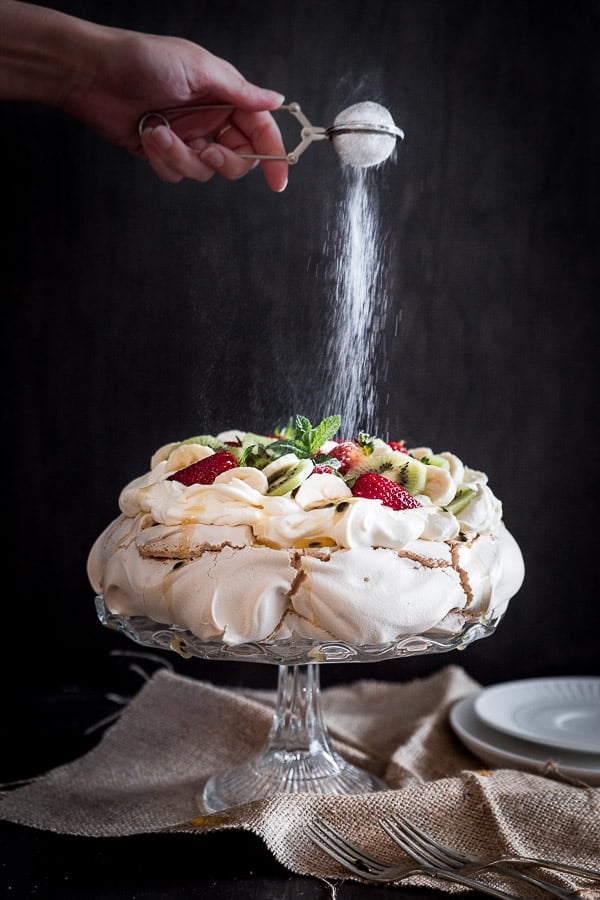
What is Pavlova?
Pavlova is a classic dessert recipe that is always served for family events or celebrations – big or small. Whether it’s a humble BBQ dinner, a birthday, Christmas, New Years Eve celebrations or even Australia Day. It’s super popular because it’s so easy to make and always looks impressive!
Pavlova is traditionally made from a base of meringue topped with whipped cream and fruit – although these days there’s lots of creative ways you can make it. Another super popular variation is to make it into a meringue roulade aka pavlova roll. See below for more ideas!
Where Does It Come From?
There’s been huge debate over whether this simple sweet dessert of meringue, cream and fruit has Australian, New Zealand or even American origins.
But to anyone who’s pondering this, we’ve got only one thing to say: Just eat it already! When pavlova tastes this good, we’ll share ownership with anybody.
No matter which origin story you subscribe to, today we’re sharing the Australian “version” handed down from our Mums and Grandmas. This is the pavlova style we grew up with, that just gets better and easier with every repetition!
Where We Learned This Recipe
Pavlova sparks so many happy feels and memories of family celebrations for us. Like that time Laura’s Aunty made the biggest pavlova she’d ever seen for Grandma’s birthday. Or those days Sarah spent inside with Mum, beating the eggs and sugar and licking the beaters afterwards.
Growing up with pavlova on both sides of the families meant we just had to share both the recipe and our love for this special dessert.
Pavlova vs Eton Mess
Eton Mess is basically a super quick 5 minute version of pavlova, made into individual portions rather than a full size dessert. It’s like a cheat-mode version, using pre-made mini meringue nests topped with sweet cream and fruit.
If you’re short on time and need a super quick dessert – or even just a mini pavlova to celebrate with friends – then our Eton Mess has you covered. You can also use your homemade mixture to make mini meringues or nests – they’ll taste much better than store-bought meringue, so it’s worth the extra effort.
What You’ll Need
The meringue shell is a super simple blend of eggs, sugar and vanilla essence, with a little vinegar and corn starch added to make it both fluffy AND crispy. A few quick notes on these ingredients:
- Eggs – For best results, make sure to use room-temperature eggs. We use chicken eggs for this recipe, but duck eggs are absolutely fabulous if you can get your hands on them!
- Sugar – We recommend caster sugar, aka super fine sugar. It dissolves into the egg whites more quickly and will give you that smooth texture you’re looking for.
- Vinegar – The acid in vinegar helps the egg whites become fluffy and hold onto all that air that’s beaten in. Regular white vinegar (or white wine vinegar) is the best choice, but you can substitute with apple cider vinegar, cream of tartar, or even lemon juice in a pinch. We don’t recommend strong dark vinegars like balsamic or malt as they’re more likely to add a strong flavour to the meringue.
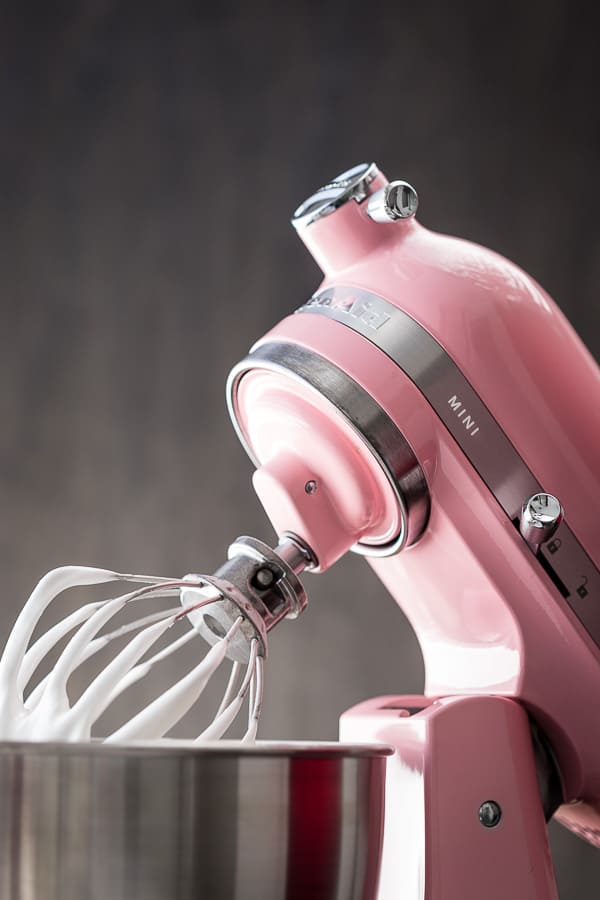
How to make Pavlova:
This is the EASY method to make pavlova which we’ve called 2-4-6-8, due to the speed settings used to get that glossy meringue mixture we’re looking for! You can make it in a Kitchenaid Mixer, a regular stand mixer, or a mixing bowl with a hand mixer and gradually increase the speed settings to get it just right.

1. 
2. 
3.
- Pop your egg whites into the mixing bowl and attach the whisk to the stand mixer (or use a hand mixer). Start by whipping them on Speed 2 then move through to Speed 4 after a couple of minutes.
- When the egg whites turn into bubbly soft peaks, up the speed to 6 and add the caster sugar and cornflour, then increase to Speed 8 for 10 – 12 minutes until you’ve got yourself a luxuriously smooth, glossy meringue mixture.
- Now bring the speed down to 4 and pour in the vinegar and vanilla essence. You might need to scrape down the meringue from the sides of the bowl every now and again with a spatula to make sure it mixes through. Let it mix for 1 minute then switch off your mixer.

4. 
5. 
6.
- Scoop out the glossy meringue mixture onto a lined baking tray and form a flat circle shape. Smooth it out or get creative with decorative patterns, twists or twirls. Pop in the oven and bake for an hour to an hour and a half until the meringue sets into a crunchy, crispy outside with a soft golden glow. When the outside is firm and dry, and cracks start to appear on the top, you’re ready to go. Switch off the oven and allow the pavlova to cool in the oven with the door slightly open.
- While the pavlova is cooling, pour your cream into your cleaned mixing bowl and pop in the freezer for 10-15 minutes. When your pavlova is cool, place the bowl back on the stand mixer (or grab your hand mixer) and whip the cream on Speed 6 – 8. Add in the sugar and vanilla essence and continue to whip until the cream thickens and holds a nice shape.
- Top your cooled pavlova with whipped cream and sliced fruit, and dust with icing sugar.
Pavlova Topping Ideas
While the magic is happening as you bake your pavlova in the oven, you’ll have plenty of time to plan your toppings. Here are a few of our favourite topping combinations to get you started!
- Classic: strawberries + kiwifruit + passionfruit + cream + icing sugar
- Mandy’s Favourite (thanks to Sarah’s Wandermum): banana + kiwifruit + passionfruit + cream
- Berry Elegant: strawberries + raspberries + blackberries + blueberries + cream
- Choc Top: nutella + strawberries + cream
- Fruity Goodness: blueberries + mango + passionfruit
Also, whatever you do, don’t skimp out on that whipped cream. Slather a nice thick layer over the top of your pavlova, and make yourself a nice base for your fruit and extra decadence for your plate.
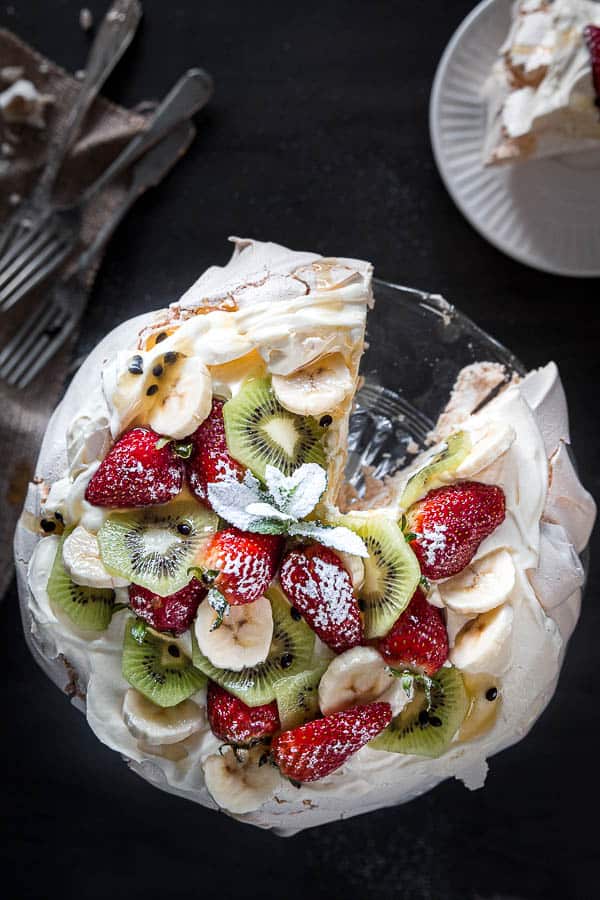
Wandercook’s Tips
- Always use room-temperature eggs – cold eggs can cause your meringue mixture to be too runny.
- Don’t be tempted to add the sugar into the egg whites too quickly. If added too soon, this can make the meringue runny.
- Give the egg whites and sugar plenty of time to combine fully. If you don’t, it can lead to a gritty texture and may cause the pavlova to crack or collapse.
- Cooking the pavlova on the lowest rack in the oven can help to stop it cracking.
- One of our readers suggested humidity can have an effect when cooking meringues! For best results, try avoiding super humid days/environments if possible.
- Leftover egg yolks? Use them to make Italian almond crescent cookies.
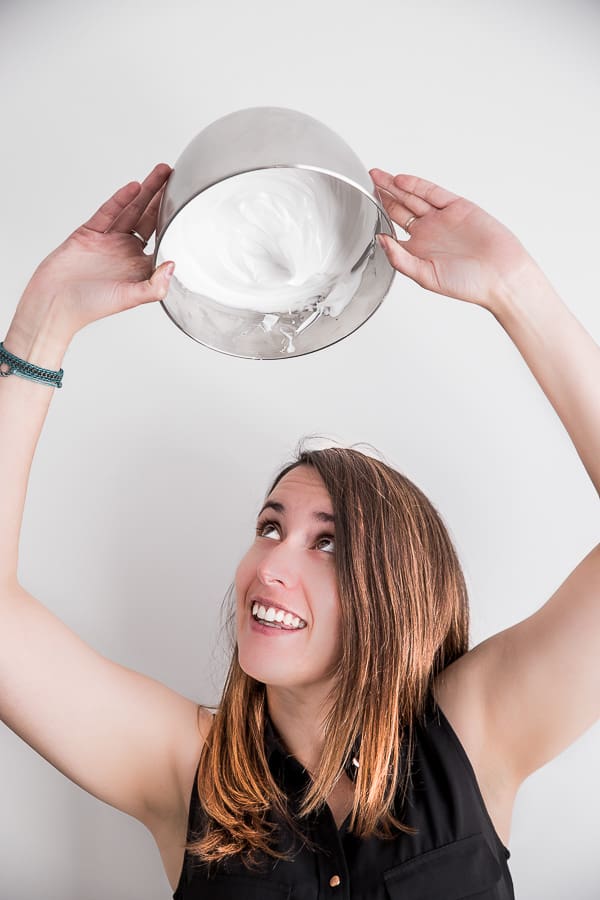
FAQs
You’ll know when it’s ready, because your meringue mixture should stay firmly stuck in the bowl, even if you tip it upside down. Testing this theory over your head is, of course, completely optional!
Our general rule is at least an hour or two, or even overnight if you want to play it safe. Once the oven is cool, the pavlova should be too, so it’s all good to take it out.
If you take the Pavlova out the oven too soon while it’s still warm this will cause it to sink, collapse and shrink from the cold air.
To help the oven cool down quicker, we open it just a crack so the hot air can escape faster without allowing the cold air to come in too quickly.
If you’re worried, leave the pavlova in the oven overnight with the door shut then top it first thing in the morning.
Don’t worry though, pav is such a forgiving recipe – even if the meringue cracks or sinks in the middle, once it’s covered in whipped cream and toppings no one will ever know. And no matter what it ends up looking like, it always tastes amazing!
Yes! You can make pavlova in advance, even up to a few days. Just store in an airtight container or wrapped in a clean tea towel. Keep the meringue base separate from toppings to keep it crisp, crunchy and fresh for when you serve it up.
It’s always best to store leftovers in the fridge, especially due to the whipped cream topping. While the shell will be softer and won’t stay as crispy, it’ll still be delicious the next day!
Variations & Substitutes
- Make Mini Pavlovas (aka Eton Mess) – Portion out the mixture into separate circles as big or as small as you like. Once cooked, top with a simple topping of whipped cream, strawberries and a sprig or two of mint leaves.
- Crush it! – Deliberately crack the pavlova into pieces, then add to a bowl and top with whipped cream and fruit. For bonus points, serve in glass for a stunning visual effect.
- Play with Shapes – Make it as a square, a wreath (perfect for Christmas!), or a love heart. Make thinner layers of pavlova, then once cooked, layer them up into stacks with the toppings as ‘fillings’ in the middle.
Want more delicious desserts? Try these:
★ Did you make this recipe? Please leave a comment and a star rating below!
Equipment
Ingredients
For the Pavlova Meringue
- 6 egg whites
- 390 g caster sugar / superfine sugar
- 1 tsp cornstarch / cornflour heaped
- 1 tsp vinegar
- 1 tsp vanilla essence
For the Whipped Cream
Optional Toppings
- 1 punnet strawberries sliced
- 1 kiwi fruit sliced
- 1 banana sliced
- 1 passionfruit pulp extracted
- 1 tbsp icing sugar / powdered sugar to sprinkle
Instructions
For the pavlova meringue:
- First up, preheat your oven to 150˚ Celsius and line your tray with baking paper.
- Pop your egg whites into the mixing bowl and attach the whisk to the stand mixer (or use a hand mixer). Start by whipping them on Speed 2 then move through to Speed 4 after a couple of minutes.6 egg whites
- When the egg whites turn into bubbly soft peaks, up the speed to 6 and add the caster sugar and cornstarch, then increase to Speed 8 for 10 – 12 minutes until you’ve got yourself a luxuriously smooth, glossy meringue mixture.390 g caster sugar / superfine sugar, 1 tsp cornstarch / cornflour
- Now bring the speed down to 4 and pour in the vinegar and vanilla essence. You might need to scrape down the meringue from the sides of the bowl every now and again with a spatula to make sure it mixes through. Let it mix for 1 minute then switch off your mixer.1 tsp vinegar, 1 tsp vanilla essence
- Scoop out the glossy meringue mixture onto a lined baking tray and form a flat circle shape. Smooth it out or get creative with decorative patterns, twists or twirls. Pop in the oven and bake for an hour to an hour and a half until the meringue sets into a crunchy, crispy outside with a soft golden glow. When the outside is firm and dry, and cracks start to appear on the top, you’re ready to go. Switch off the oven and allow the pavlova to cool in the oven with the door slightly open.
For the whipped cream:
- While the pavlova is cooling, pour your cream into your cleaned mixing bowl and pop in the freezer for 10-15 minutes. When your pavlova is cool, place the bowl back on the stand mixer (or grab your hand mixer) and whip the cream on Speed 6 – 8. Add in the caster sugar and vanilla essence and continue to whip until the cream thickens and holds a nice shape.400 g thickened cream / heavy cream, 75 g caster sugar / superfine sugar, 1 tsp vanilla essence
To assemble:
- Top your cooled pavlova with whipped cream and sliced fruit such as strawberries, kiwi fruit, banana and passionfruit, and sprinkle with icing sugar.1 punnet strawberries, 1 kiwi fruit, 1 banana, 1 passionfruit, 1 tbsp icing sugar / powdered sugar
Video
Recipe Notes
- Eggs – For best results, make sure to use room-temperature eggs – cold eggs can cause your meringue mixture to be too runny. We use chicken eggs for this recipe, but duck eggs are absolutely fabulous if you can get your hands on them!
- Sugar – We recommend caster sugar, aka superfine sugar. It dissolves into the egg whites more quickly and will give you that smooth texture you’re looking for. Don’t be tempted to add the sugar into the egg whites too quickly. If added too soon, this can make the meringue runny.
- Vinegar – The acid in vinegar helps the egg whites become fluffy and hold onto all that air that’s beaten in. Regular white vinegar (or white wine vinegar) is the best choice, but you can substitute with apple cider vinegar, cream of tartar, or even lemon juice in a pinch. We don’t recommend strong dark vinegars like balsamic or malt as they’re more likely to add a strong flavour to the meringue.
- Give it Time – Give the egg whites and sugar plenty of time to combine fully. If you don’t, it can lead to a gritty texture and may cause the pavlova to crack or collapse.
- Stop it Cracking or Collapsing – Cooking the pavlova on the lowest rack in the oven can help to stop it cracking. Humidity can have an effect when cooking meringues -for best results, try avoiding super humid days/environments if possible. Both cracking and collapsing could be caused by taking the pavlova out of the oven too soon while it’s still warm. To help the oven cool down quicker, open it just slightly so the hot air can escape faster without allowing the cold air to come in too quickly. If you’re worried, leave the pavlova in the oven overnight with the door shut then top it first thing in the morning.
- Make Mini Pavlovas (aka Eton Mess) – Portion out the mixture into separate circles as big or as small as you like. Once cooked, top with a simple topping of whipped cream, strawberries and a sprig or two of mint leaves.
- Crush it! – Deliberately crack the pavlova into pieces, then add to a bowl and top with whipped cream and fruit. For bonus points, serve in glass for a stunning visual effect.
- Play with Shapes – Make it as a square, a wreath (perfect for Christmas!), or a love heart. Make thinner layers of pavlova, then once cooked, layer them up into stacks with the toppings as ‘fillings’ in the middle.
Nutrition
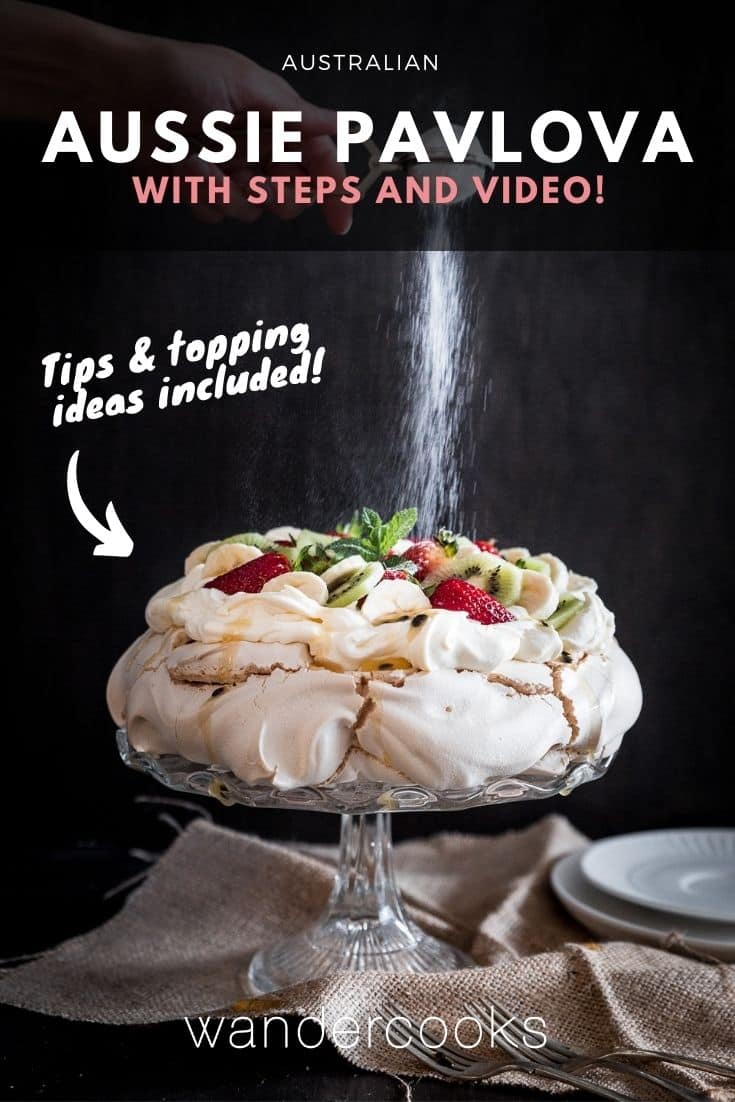

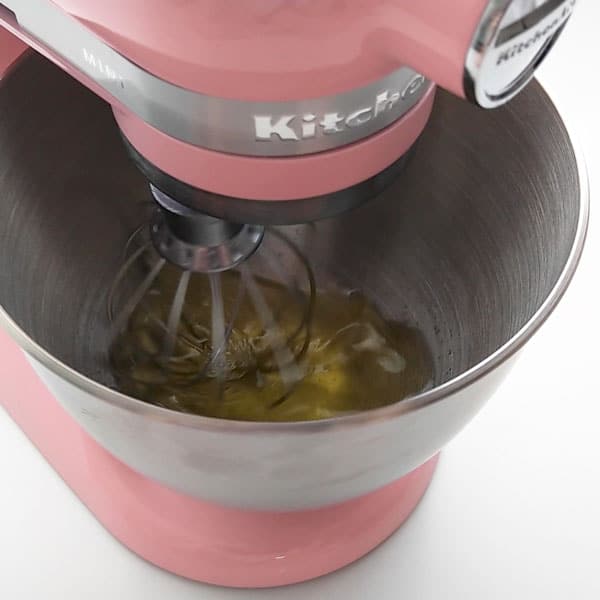
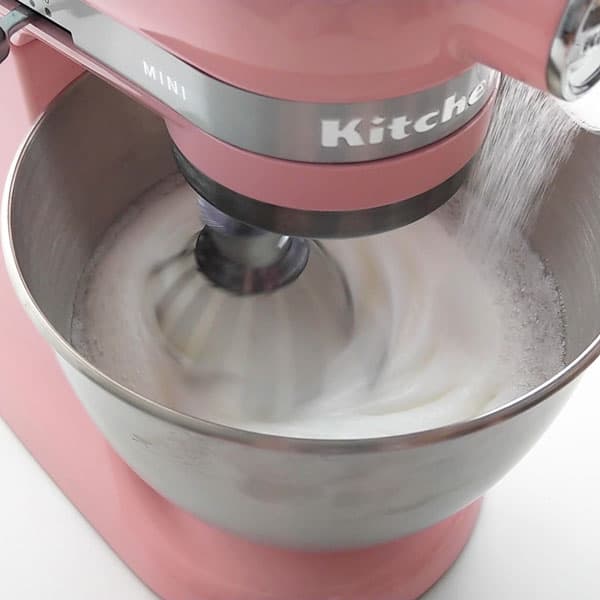
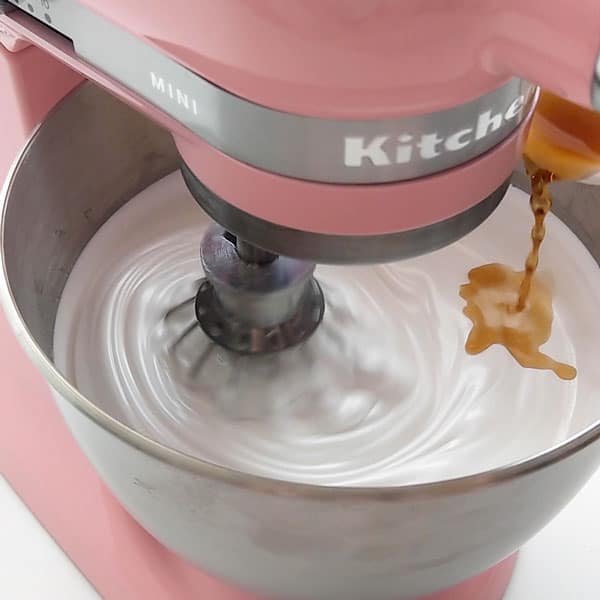
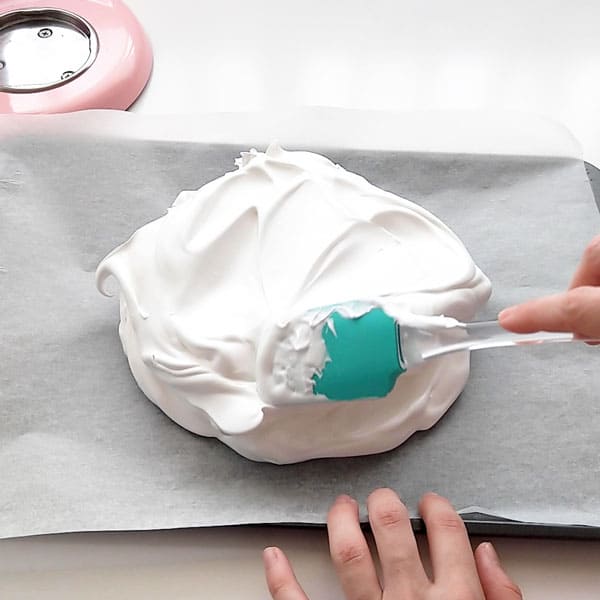
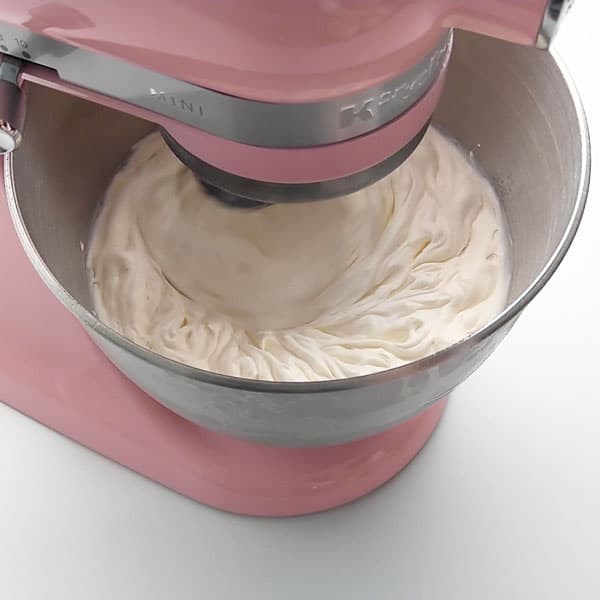
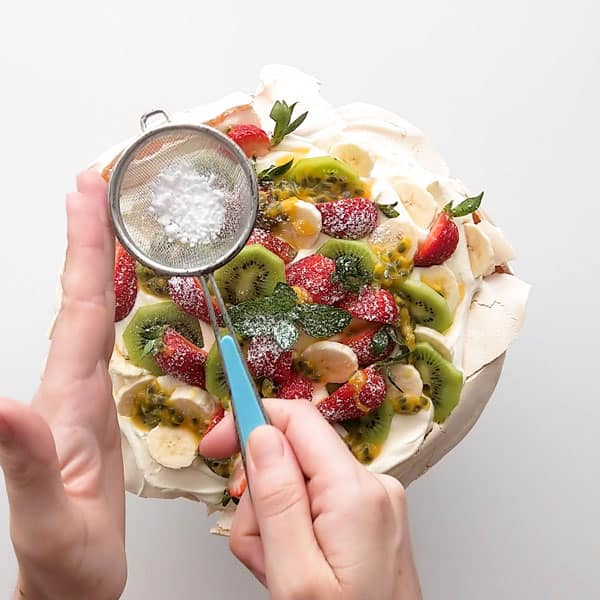
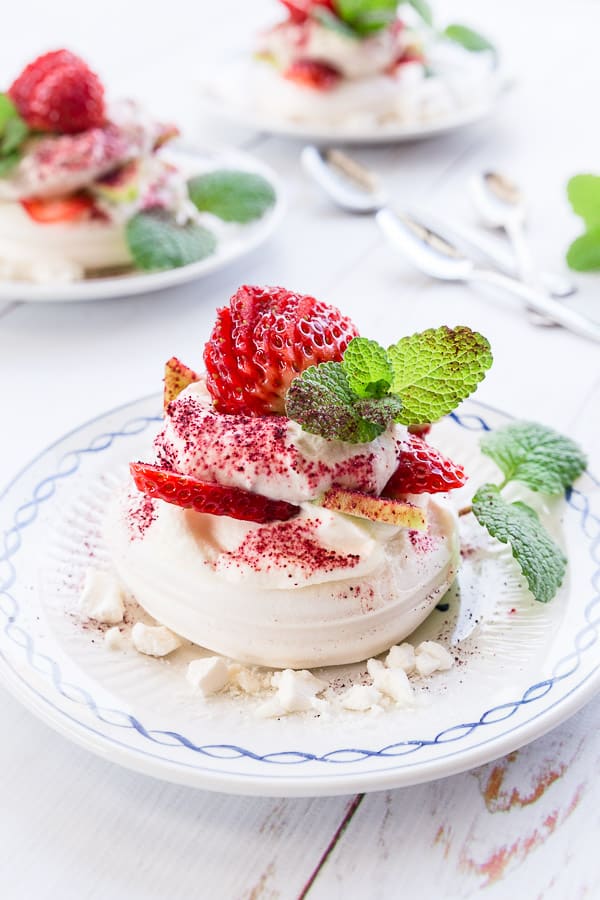
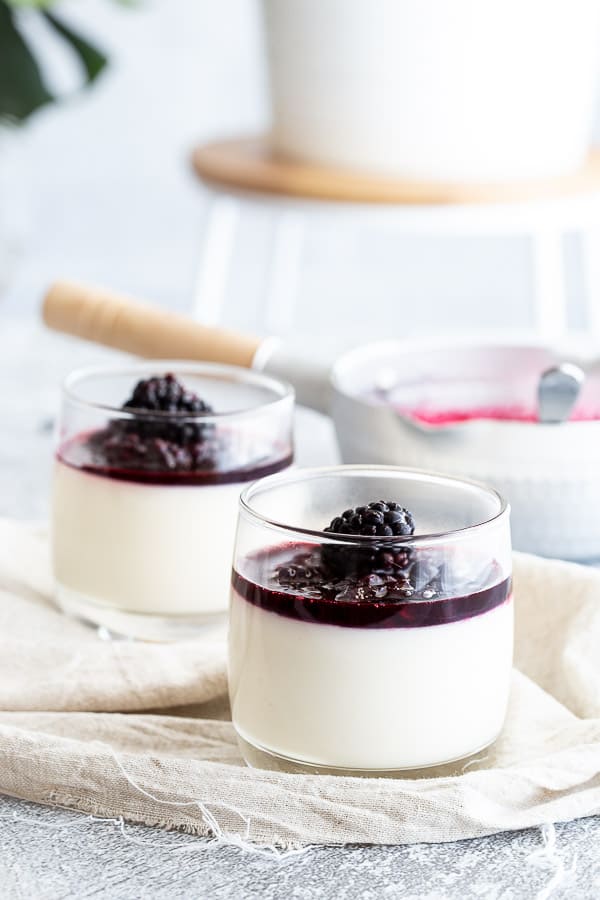
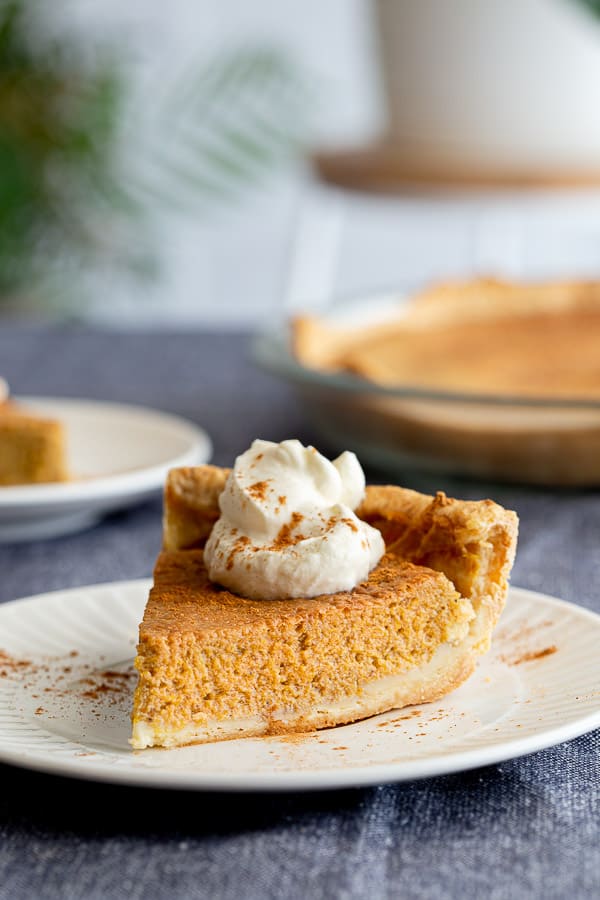
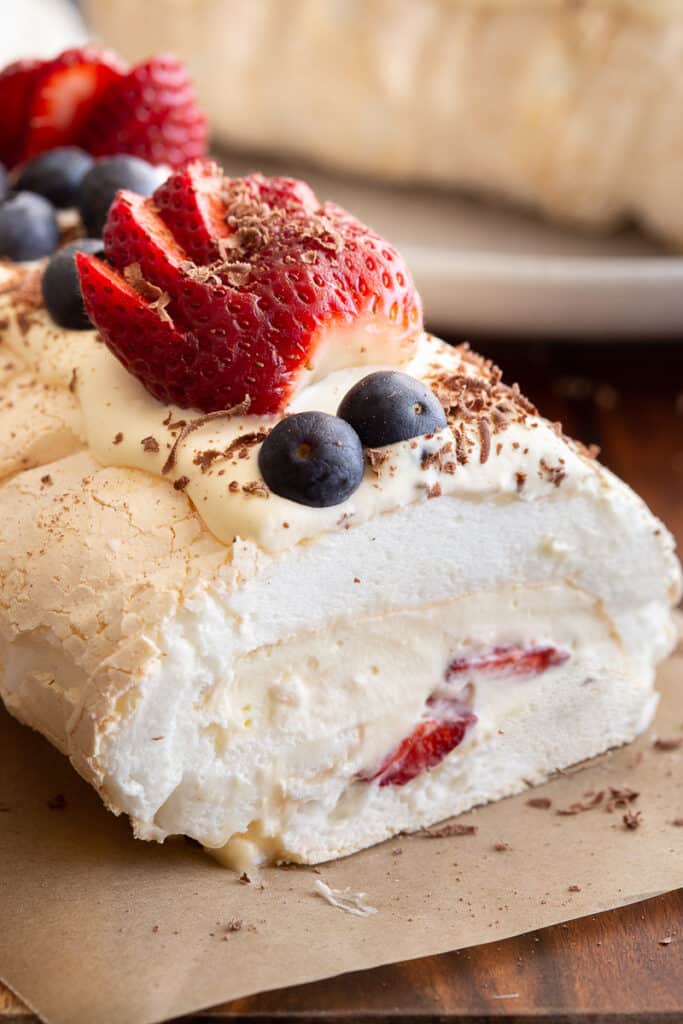
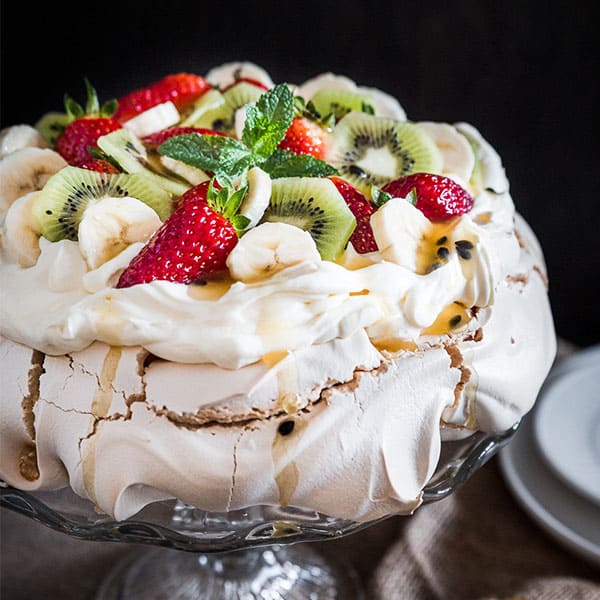



110 Comments
Andrew D
19/08/2020 at 1:57 pmOnly one word awesome describes this
Had never heard of pavlova much less eaten it, read about it on BBC about the Australia vs NZ ownership issues and it intrigued me enough to find a recipe and try. I tried yours…. best to make a downunder dessert with a recipe posted from downunder. t was superb. However my meringue rose too quickly and then cracked and then semi-collapsed into into own giant bubble long before I had even switched off the oven. Not that it made any tangible difference since the topping and the fruit covered it (used mango, kiwi, strawberry, blueberry and raspberry). Also try as I hard as I could, I could not get my meringue mixture to be semi-solid. Milky glossy white it was but but semi-liquid. so could not shape it. The egg whites were too watery. Do you think one needs to use freshly laid eggs?
a big thumbs up…
From Houston USA
Wandercooks
19/08/2020 at 4:43 pmAww thanks Andrew!
Well done on your first Aussie pavlova! That’s one thing I love about making it – no matter how it comes out the oven – once you have the topping on it tastes just as good haha!
Okay let’s tackle both parts:
1. The egg whites: Try using eggs at room temperature and they don’t have to be fresh. Next, try beating the whites for a little longer, before adding the sugar. If added too soon, this can make the meringue runny. You can also try slowly adding in the sugar instead of all at once. Hopefully this should help the meringue form nice and stiff peaks – passing the ‘over the head’ test!
2. The cracked meringue: Cracking is normal, but the semi-collapse may be avoided by having the thicker meringue mix as above and making sure not to open that oven door – I’d leave the next one in overnight and see if that comes out any better.
Thanks for your questions, and good luck on the next batch! 🙂
From the Down Unders – Sarah & Laura hehe
Andrew D
30/08/2020 at 4:00 amThanks for your feedback but sorry to bug you but last time I did cool it in the overnight but the room temperature advice is well taken. I tried it again today with the eggs at room temperature and it was much thicker. However. I am not sure that I could have shaped it.
That being said it still rose at an alarming rate but instead of collapsing cracked itself into a gigantic piece
However as you said who cares!!! Tastes gorgeous anyway
Wandercooks
30/08/2020 at 11:18 amHmm alright, it sounds like the mixture is getting to a better texture. Next, let’s turn our attention to the oven. It may be that it’s cooking the base way too quick – resulting in this giant crack. Try turning the oven down 10C / 50F and place the pavlova on the lowest rung possible. Hopefully, allowing it to cook a little slower will allow it to expand without the cracking. Fingers crossed for you this time Andrew! You’ve got this! 😀 (Glad you’re enjoying the baking and eating in the meantime 😉 haha)
Kelley
10/09/2020 at 7:32 amAndrew, I see you’re in Houston so you can laugh at my advice. Try to not do this on a day when it’s really humid or raining. Humidity can really do a number on meringue.I haven’t tried this recipe yet but this is my experience from making meringue cookies or meringue for pies.
Wandercooks
10/09/2020 at 7:48 amThanks for the advice Kelley! Andrew, I hope this helps too. 😀
Nileshni
15/08/2020 at 7:14 pmThanks for the receipe. Was so easy to follow. I want to share my pavlova as it started cracking after 40mins in the oven. I did cook bit longer and left on oven to cool. Wanted to know the cracks around and inside the shell is expected and the colour was bit golden on the outside. Either way tasted devine. My 1st attempt and im so happy. Not sure how i can share my pic.
Wandercooks
17/08/2020 at 10:16 amHey Nileshni, sounds like you did an amazing job. It’s fine for there to be a little cracking and it can also go a slight golden colour on the shell – ours does this too. So well done! Hope you enjoy cooking it again. If you want less cracking, you can try turning down your oven slightly, this will slow the expanding process and may help. Hope this helps! 🙂
Becky Buckland
08/07/2020 at 11:08 pmQuestion regarding the recipe ingredients:
For the American, there is a huge difference between corn flour and corn starch. Which one are you referring to for this recipe? The other recipes I have looked at require corn starch
Help please! Wanting to try this for an 80th Birthday celebration coming up in a few days!
Wandercooks
09/07/2020 at 9:30 amCorn starch for American bakers! 🙂 It’s known as corn flour in Australia. I’ll update the recipe now. Thanks for asking to confirm and have fun baking for the 80th! 🙂
Jo
28/12/2019 at 10:34 pmAwesome recipe. No fail. I made mine into a wreath shape and it was a hit
Wandercooks
07/01/2020 at 2:43 pmWhat a great idea! I think the pavlova would’ve looked magical as a wreath! If you took any photos, you’ll have to send them through! 🙂
PJ from California
24/12/2019 at 4:23 amI was first introduced to Pavlova in 2000 when I spent a Christmas in Australia with some friends. When I started my own family I wanted to introduce them to the deliciousness I discovered down under! I’ve been making your recipe for 3 years now and it’s perfect every time! My kids ask for it every Christmas Eve. thanks for sharing it with us.
Wandercooks
07/01/2020 at 2:45 pmHey PJ, what a cool story! That’s so amazing, it means a lot to us that you’ve found our recipe so helpful these last few years. 🙂 What are your favourite toppings for your renditions?
Eleanor
04/11/2019 at 12:51 pmThis looks amazing… I am pretty sure I would not be able to pull it off but I think I may be able to convince someone else to, making me official taster!
Wandercooks
05/11/2019 at 12:24 pmSounds like a plan! haha
Annie @ Annie's Noms
15/07/2019 at 8:30 pmThis is stunning!!! I do love a good pavlova, but don’t make them as much as I should! I bet it tastes so amazing with all the fruit, the kiwi is a great addition!
Wandercooks
17/07/2019 at 4:38 pmThe kiwi goes great on this, especially when you find a nice ripe, sweet one. Yum!
Danielle Wolter
15/07/2019 at 8:26 pmThis is so gorgeous! I love pavlova. It’s so fresh and light and delicious. I am partial to the outer shell, but do love the center as well 🙂
Wandercooks
17/07/2019 at 4:38 pmOoooh, yeah – that’s a tough one. I think the outer shell is my favourite too!
Farah
15/07/2019 at 6:08 pmThis is absolutely stunning! Making a pavlova isn’t as finnicky as I was scared it would be. Trying this!
Wandercooks
17/07/2019 at 4:37 pmIt definitely isn’t, especially if you have a mixer, that’s most of the work done for you right there!
Shashi at SavorySpin
15/07/2019 at 6:05 pmWow what a gorgeous pavlova – such a simple yet stunning dessert for guests!
Wandercooks
17/07/2019 at 4:36 pmCheers Shashi! It is a great one for guests, always looks so much fancier than the effort you put in haha!
Nickki
11/02/2019 at 9:19 pmWhat a stunning pavlova and some great tips! This is my all time favourite dessert- I can never say no to a big slice! And that mini kitchen aid is adorable!! I wonder if I can justify buying another one…
Wandercooks
15/03/2019 at 4:01 pmHaha thank you, we love our little baby pink KitchenAid too haha 😀 So handy! How good is pavlova haha, I love that you CAN have a big slice since it’s so light and fluffy you can totally justify eating more in one go.
Camilla Hawkins
04/02/2019 at 10:16 pmLoving this Pavlova, it looks so decadent and inviting! A fab centre piece for any get together:-)
Wandercooks
05/02/2019 at 11:50 amAww thanks Camilla, so glad you like it! 🙂
Janice
04/02/2019 at 2:33 amI adore pavlova and make it often. Yours looks totally delicious
Wandercooks
04/02/2019 at 9:04 amThanks Janice, glad you like it. 🙂
Nova
06/01/2019 at 12:49 pmFirst of all thank you for a delightful recipe, I’ve been making pavs for years and have my own trusted recipe but this one looks great and the photography is fabulous.
I can understand the frustration of Ralph who probably thinks Australia steal most things from NZ (think Phar Lap and Russell Crowe) but he is correct in the publication of the recipe in 1926.
As for the kiwifruit it did originate from China and was then known as a Chinese gooseberry. The name later got changed when it’s cultivation and marketing became viable in NZ where the agricultural climate and environment proved a boon for growers. Now it is even grown in parts of Australia. I think we can all agree that no matter where something is grown anywhere in the world we can all enjoy it, after all the humble potato originated in Peru thousands of years ago.
My kitchenaid is the Artisan tilt-back and has been my trusted companion for years. You have to have one if you’re to make an Aussie or Kiwi pav. Happy New Year!
Wandercooks
07/01/2019 at 1:28 pmWell said Nova – Happy New Year to you too! Happy Pav eating and cooking haha. Agree with the KitchenAid, it’s definitely made us ‘Pav Pros’!
Ralph
25/12/2018 at 6:09 amI have to challenge you on three fronts:
1. Pavlova or as we more locally call it, Pav, IS NOT an Australian dessert. The first recorded publication of a Pav recipe was in a local newspaper in 1923 in New Zealand.
2. The nonsense of tipping the bowl over your head is not part of any recipe or tip from that era.
3. The original pav was suggested to be decorated with whipped cream and passionfruit. Kiwifruit are just that, from New Zealand as the name suggests and nothing to do with Australia.
If you dont know where New Zealand is in the world, look on a world map and find Australia, then look east in the Pacific and you will find the beautiful 3 main islands of New Zealand.
Wandercooks
25/12/2018 at 7:12 amMorning Ralph and Merry Christmas!
That is quite the challenge you’ve posed! Here’s our answers:
1. Correct! It does have New Zealand origins as we mentioned in our story. This is our Australian version of the recipe – because this is the way we grew up eating it with our parents, and how my Mum made it. So this is a special recipe, close to our hearts.
2. It’s true – although it’s a lot of fun to do, isn’t it!
3. Kiwifruit is actually from China and was brought out to New Zealand at the turn of the century. Again, these were toppings my Mum did, and all that matters to us is that it tastes good. You can put any toppings you prefer – recipes are always fun to experiment with!
We definitely know where NZ is – we live in Australia.
Thanks for this morning’s challenge – and have fun cooking these holidays! 🙂
BLAY-CARRÈRE Isabelle
02/09/2019 at 1:44 amDélicieuse, À chaque fois que je viens en Australie, je me régale de Pavlova.
Après avoir essayé différente recette version française qui jusqu’à maintenant pas terrible, voilà enfin la vrai recette australienne.
La meringue est extra, croquante et moelleuse, sa crème fouettée à tomber…. Merci pour cette merveilleuse recette… j’en referais.😍
Wandercooks
05/09/2019 at 10:30 amC’est si bon à entendre! Je vous remercie pour vos aimables paroles. J’espère que vous apprécierez le Pavlova! (That’s so good to hear! Thank you for your kind words. Hope you enjoy the Pavlova!)